Copyright © Stephen E. Jones[1]
This is part #23, "The man on the Shroud: Real human blood," of my series, "The evidence is overwhelming that the Turin Shroud is Jesus’ burial sheet!" For more information about this series, see the "Main index #1" and "The man on the Shroud #8." See also "2.5. The bloodstains." Emphases are mine unless otherwise indicated.
[Main index #1] [Previous: X-rays #22] [Next: Blood clots intact #24]
- The man on the Shroud #8
- Real human blood #23
Introduction The blood of the man on the Shroud is real human blood[2].
[Above (enlarge): "Close-up of a blood area on the Shroud, as photographed using the portable photomicroscope"[3].
"As for the `blood' [sic] stains, according to John H. Heller's and Alan D. Adler's studies these derived from genuine clotted wounds, and they pass eleven different diagnostic tests, enabling them to be pronounced to be true blood in any court of law. Blood constituents such as proteins, albumen, haem products, and the bile pigment bilirubin (on which Adler is an acknowledged expert) can all be determined to be present. One remarkable feature noted by Adler is that where blood occurs in the same region as body image, the cloth fibres lack body image characteristics below the bloodstain, suggesting that the blood was on the cloth before the body image-making process began[4]. That is hardly the way any artist might be expected to work"[5].]Real blood The bloodstains of the man on the Shroud are real blood[6]. Table 5 below summarizes the tests employed by Adler
[Above (enlarge)[7]: Table 5: Summary of tests by Adler and Heller which confirmed that the blood on the Shroud was real blood[8]. At the public final meeting of STURP in New London, Connecticut in October 1981, after explaining each item in this table, Adler, who had "already published close to a hundred articles on his blood research; forty-odd concerned porphyrins"[9], concluded:
"That means that the red stuff on the Shroud is emphatically, and without any reservation, nothing else but B-L-O-O-D!"[10]]and Heller between 1979 and 1981[11] which confirmed that the blood on the Shroud was real blood[12]. STURP in its 1981 final report concluded that the blood on the Shroud was real blood[13].
Clotted blood The bloodstains are clotted blood[14] in that they are thickened on the edges[15]. As blood dries it forms a scab and contracts, thickening the edge of the scab and exuding serum onto the surface and edges of the contracting clot[16].
Serum halos The border of every bloodstain under ultraviolet light shows a typical yellowish fluorescence of a serum exudate ring or halo around a scab as expected for blood clot retraction[17]. These serum halos confirm that the Shroud's bloodstains are real blood[18].
Serum albumin is the most abundant blood plasma protein and is produced in the liver[19]. These serum haloes above tested positive for serum albumin and they also gave a positive immuno-chemical test with albumin serum[20]. Positive serum albumin tests were also found in areas adjacent to the blood, for example the lance wound area[21].
Distinction between arterial and venous bloodflows The distinction between arterial and venous blood flows is evident in some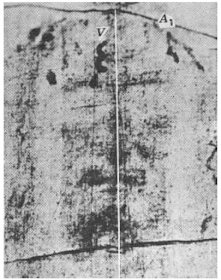
[Above (enlarge): Distinction between venous blood in the reversed `3' or epsilon bloodstain, which is correctly from the frontal vein "V", and arterial blood which is from the frontal branch of the superficial temple artery "Al" on the forehead.[22].]
bloodstains on the man's forehead[23]. Venous blood appears darker and thicker because it flows more slowly than arterial blood[24]. The large reversed `3' or epsilon-shaped blood clot on the man's forehead is an example of a large venous blood flow[25].The distinction between arterial and venous blood was not even discovered until 1593 by Andrea Cesalpino (c. 1524-1603)[26], more than 230 years after the Shroud first appeared in undisputed history at Lirey, France in c.1355[27]!
Distinction between premortem and and postmortem blood The bloodflows on and from the man on the Shroud can be distinguished as antemortem or premortem (before death) and postmortem (after death)[28]. For example, the bloodflows on the face are all premortem, as shown by computer mapping which found that all streams of blood on the face flow down the face and none of them flow toward the back of the neck or head[29]! This means the man on the Shroud died on the cross in an upright position and then the blood 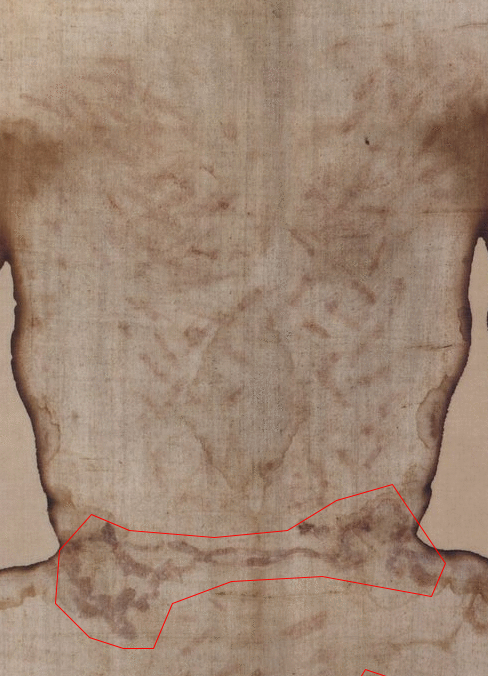 in his head had drained down internally while he was still on the cross[30]. Examples of postmortem bloodflows include the spear wound in the side[31], the pool of blood across the small of the back from that spear wound[32] [Right (enlarge)[33].], and the trickle of blood from the right foot after the removal of the nail[34]. These had oozed with gravity and showed no sign of force from a pumping heart[35].
in his head had drained down internally while he was still on the cross[30]. Examples of postmortem bloodflows include the spear wound in the side[31], the pool of blood across the small of the back from that spear wound[32] [Right (enlarge)[33].], and the trickle of blood from the right foot after the removal of the nail[34]. These had oozed with gravity and showed no sign of force from a pumping heart[35].
Blood on face out of stereoregister with image The blood marks on the man's face are not in stereoregister with the image of his face[36]. In 1986 Dr Gilbert Lavoie was looking at a life-size positive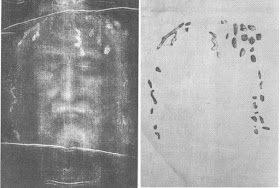
[Above (enlarge): Fig. 1, Shroud face, positive image (left), and Fig. 3, cutouts of the blood marks on the face and hair of the Shroud (right)[37].
[Below (enlarge): Fig. 4, cutouts of the blood marks above right draped over a man's face (left), and Fig. 5, `blood' marks painted on the man's face through the cutouts[38].]
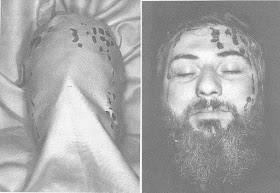 photograph of the Shroud face (Fig. 1), when it occurred to him that the blood was a little too far out on either side of the face[39]. To test this he asked his daughters to outline on tracing paper the blood marks on the forehead and hair, trace the position of the eyes and nose, make a cutout of the tracing, remove the paper within the outlined blood marks, and make holes at the eyes large enough to see through[40]. When Lavoie placed the tracing paper with its blood mark cutouts over his face, aligning the eyes and nose with his own, and looked through the eye slits in a mirror, it confirmed that the blood in the hair is actually on the sides of the face[41]! Lavoie then visually reproduced this by painting through the blood mark cutouts onto the face of a bearded man volunteer (see Fig. 1, 3, 4 and 5 above)[42]. This means that the blood on the Shroud and the body image were caused by two different processes separated in space and time[43]! The blood marks have been transferred to the cloth by direct contact with clots from wounds, while the body image has been projected onto the cloth by a non-contact type of radiation[44]! This is explained by STURP's John P. Jackson's "cloth collapse theory" where the body became "mechanically transparent"[45], and the cloth fell through the space where the body was, flattening out due to air resistance[46].
photograph of the Shroud face (Fig. 1), when it occurred to him that the blood was a little too far out on either side of the face[39]. To test this he asked his daughters to outline on tracing paper the blood marks on the forehead and hair, trace the position of the eyes and nose, make a cutout of the tracing, remove the paper within the outlined blood marks, and make holes at the eyes large enough to see through[40]. When Lavoie placed the tracing paper with its blood mark cutouts over his face, aligning the eyes and nose with his own, and looked through the eye slits in a mirror, it confirmed that the blood in the hair is actually on the sides of the face[41]! Lavoie then visually reproduced this by painting through the blood mark cutouts onto the face of a bearded man volunteer (see Fig. 1, 3, 4 and 5 above)[42]. This means that the blood on the Shroud and the body image were caused by two different processes separated in space and time[43]! The blood marks have been transferred to the cloth by direct contact with clots from wounds, while the body image has been projected onto the cloth by a non-contact type of radiation[44]! This is explained by STURP's John P. Jackson's "cloth collapse theory" where the body became "mechanically transparent"[45], and the cloth fell through the space where the body was, flattening out due to air resistance[46].
Bilirubin A test for the presence of proteins in the Shroud man's blood returned an extraordinarily high bilirubin count[47]. In traumatic shock, as would be experienced under flogging and crucifixion, the liver converts hemoglobin from burst red cells into bilirubin, which remains in the blood clots and gives them a red to orange colour[48]. Sceptics had long criticised the Shroud's blood for being too red, pointing out that aged blood normally turns black[49]. But the red colour of the Shroud's blood supports the forensic conclusion that the blood was from someone who suffered a traumatic death as depicted in the body images[50], which Jesus of Nazareth did[51]!
Human blood In 1980 an ultraviolet microspectrophotometric study of blood particles from STURP's Shroud sticky tapes, found that the near UV peak for albumin bound bilirubin is consistent with a primate origin, and therefore supporting the identification of a human source for the blood marks[52]. In 1983 Professor Pierluigi Baima-Bollone (1937-), medical examiner at the University of Turin[53], by means of fluorescent antigen-antibody reactions, confirmed that the Shroud blood is indeed human blood[54]. Then in 1983[55] and at the 1984 Italian National Shroud Congress, Professors Baima-Bollone and Agostino Gaglio reported that they had confirmed the identification of the blood group AB in Shroud bloodstains[56] and that they had discovered human red blood corpuscles on the Shroud, using a scanning electron microscope[57]. They also showed that they had verified the presence of human epidermis (skin) cells in the area of the nail wound in the feet by an immuno-histo-chemical process[58].
Crucifixion The bloodstains on the Shroud are consistent with that of a man who had been beaten and then died in the position of crucifixion[59], as described in the Gospels of Christ's crucifixion[60]. The V-shaped blood flows on the arms[61] shows they were in an elevated and extended position at the time the wounds were 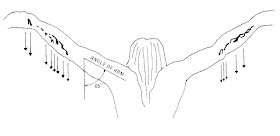
[Above (enlarge): The angle of the arms at crucifixion, deducible from the Shroud by determining the path of the blood flows in following the course of gravity. The main angle appears to have been 65 degrees, but there is evidence that at some stages the forearms were at 55 degrees, indicating that the man of the Shroud sought to raise himself [to breathe-see below]; probably continually, during crucifixion"[62].]
bleeding[63]. Dr Gilbert Lavoie found by experiments in the clotting of blood and its transfer onto a linen cloth that to produce bloodstains like the Shroud's, the blood needed to clot in a vertical position, and it needed to be transferred to the cloth within two hours[64]!
Blood and water On the man's right side there is a large blood-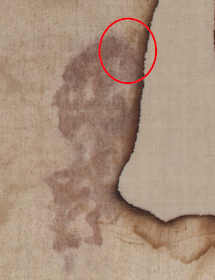
[Above (enlarge)[65]: Large bloodstain on the man's right side, showing the wound (circled in red) which caused it and which matches a Roman lance. Dark and light areas within the stain correspond to the "blood and water" that the Apostle John witnessed flow from the dead Jesus on the cross when He was pierced in the side by a Roman soldier's spear thrust (John 19:33-34). The light coloured area on the right is the new backing cloth to which areas burnt in the 1532 fire were sewn on to, as part of the 2002 restoration.]
stain[66], comprising blood from the heart[67] and watery fluid from the heart's pericardial sac[68] and the pleural (lung) cavity[69]. Near the top of the stain can be seen the wound which caused it (see above circled in red)[70], and which matches a Roman lancea[71], the very weapon that John's gospel records was thrust into Jesus' side[72] (see below), inserted etween the between the fifth and sixth ribs[73]. A Roman lance thrust upward into that ribcage region would have pierced the right atrium (auricle) of the heart[74], which fills with blood upon death[75]. This corresponds with the eyewitness (Jn 19:35) testimony of the Apostle John[76] in John 19:33-34[77]:
"But when they came to Jesus and saw that he was already dead, they did not break his legs. But one of the soldiers pierced his side with a spear, and at once there came out blood and water."As the above passage implies, it was standard practice for Roman crucifixion squads to break the legs of crucifixion victims with an iron club (called crurifragium)[78], to hasten their death by not being able to push up with their legs to exhale[79]. That the flow of "blood and water" from Jesus' lanced heart was rare (if not unique) is evident in that the Apostle John recorded it and later referred to it in one of his letters (1Jn 5:6). Moreover, Christian apologists of the second and third centuries, a time of frequent public crucifixions which only ended in AD 337 when they were abolished by Emperor Constantine the Great, argued that the flow of blood and water from Jesus' side was a miracle[80]. This argument would only work if their contemporaries were unaware of it having happened in any other crucifixions. That the same rare (if not unique)[81] flow of blood and watery fluid is found on the Shroud[82] is further proof beyond reasonable doubt (given the problems of the forgery theory - see future below) that the Shroud of Turin is the very burial sheet of Jesus[83]!
Sudarium of Oviedo The bloodstains on the Sudarium of Oviedo are a mixture of blood and watery fluid[84], produced not by a spear in the side but by blood and lung fluid issuing from its crucifixion victim's nose when he was taken down from his cross[85]. This is consistent with the medical findings that the man of the Shroud's lungs would have filled with fluid caused by the scourging and is compatible with the Apostle John's eyewitness account (see above) that when Jesus' side was pierced by a Roman soldier's lance "immediately there came out blood and water" (Jn 19:34)[86]. This blood and watery lung fluid found on both the Shroud and the Sudarium of Oviedo are among the many similarities which indicate, in Adler's words, "that these two cloths were in contact with the same wounded body"[87]. And therefore that the Sudarium of Oviedo is "the face cloth [Greek soudarion], which had been on Jesus' head" (Jn 20:7)[88]!
Problems for the forgery theory (see previous three: #20, #21 and #22). No known artist has ever used blood to depict blood. Heller, who had been a Professor of Internal Medicine at Yale asked several professors of art history at Yale and Harvard if they knew of any artist, fourteenth century or earlier, who had used blood to paint blood and their answer was uniformly negative[89]. Reasons why artists would not use blood to depict blood include: artists sought permanent colors and blood was not long-lasting[90]; and normal blood quickly turns dark, due to the cause of its red colour, hemoglobin, being oxidised in air and becoming methemoglobin, which is bluish-brown in color[91] No artist has ever depicted Jesus's wounds with clotted blood but only with free-flowing blood[92]. Since the bloodstains on the Shroud are real, human, clotted blood, its artist/forger would have had to have a supply of traumatic clotted blood exudates from a human and then painted them in a forensically correct manner as they are on the Shroud[93]. He would have needed to take that clotted blood exudate within a 20-minute period after the clotting had begun[94]. He then would have had to paint it on the cloth with the thousands of blood serum edges, which are only clearly visible in ultraviolet light, and with all the other forensic precision that is characteristic of the blood on the Shroud[95]. Since the serum exudate rings are only obviously evident under ultraviolet a medieval or earlier forger would not only require a knowledge of the physiology of clot retraction, but would also have produced images of serum rings that are only obviously evident under ultraviolet light[96]. But in the 1350s when the Shroud first appeared in undisputed history, no one had the medical knowledge of the details of blood clotting[97]. Adler pointed out:
"The presence of these serum rings makes the notion of a forger painting in the blood images with the correct chemical composition before the image forming process [see "No image under blood" #25] and properly out of stereoregister virtually impossible"[98].He therefore concluded:
"I believe most reasonable people would conclude that it is simply impossible that an artist could have produced the blood imprints on the Shroud of Turin. Rather, it is logical to conclude, from the nature and characteristics of the bloodstains on the Shroud, that the cloth once enfolded the body of a severely beaten and crucified human being"[99]!
Continued in part #24 of this series.
Notes
1. This post is copyright. I grant permission to quote from any part of this post (but not the whole post), provided it includes a reference citing my name, its subject heading, its date and a hyperlink back to this post. [return]
2. Bulst, W., 1986, "Some Considerations on the Genesis of the Body Image on the Turin Shroud," Shroud Spectrum International, No. 19, June, pp.2-14, 2, 4,5; Morgan, R., 1988, "World Reaction to Carbon Dating a Farce," October, Shroud News, No 49, pp.3-18, 3; Minor, M., 1990, "Shroud of Turin Manuscript Discovered By Texas Member," [originally "A Lawyer Argues for Authenticity of the Shroud of Turin"], The Manuscript Society News, Vol. XI, No. 4, Fall, pp.117-122, 122; Iannone, J.C., 1998,"The Mystery of the Shroud of Turin: New Scientific Evidence," St Pauls: Staten Island NY, p.178; McDonnell, D.J., 2003, "The Great Holy Shroud Dating Fraud of 1988," 4 November; Oxley, M., 2010, "The Challenge of the Shroud: History, Science and the Shroud of Turin," AuthorHouse: Milton Keynes UK, p.238. [return]
3. Wilson, I. & Schwortz, B., 2000, "The Turin Shroud: The Illustrated Evidence," Michael O'Mara Books: London, p.75. [return]
4. Adler, A.D., "Chemical and Physical Characteristics of the Blood Stains," in Scannerini, S. & Savarino, P., eds, 2000, "The Turin Shroud: Past, Present and Future," International scientific symposium, Turin, 2-5 March 2000," Effatà: Cantalupa, pp.219-233, 228. [return]
5. Wilson & Schwortz, 2000, p.75. [return]
6. Heller, J.H. & Adler, A.D., 1981, "A Chemical Investigation of the Shroud of Turin," in Adler, A.D. & Crispino, D., ed., 2002, "The Orphaned Manuscript: A Gathering of Publications on the Shroud of Turin," Effatà Editrice: Cantalupa, Italy, pp.34-57, 41, 47. [return]
7. Heller & Adler, 1981, p.52. [return]
8. Heller, J.H., 1983, "Report on the Shroud of Turin," Houghton Mifflin Co: Boston MA, pp.215-216; Antonacci, M., 2000, "Resurrection of the Shroud: New Scientific, Medical, and Archeological Evidence," M. Evans & Co: New York NY, p.25. [return]
9. Crispino, D., "Foreword," in Adler & Crispino, 2002, p.v-ix, v. [return]
10. Heller, 1983, p.216. [return]
11. Heller, 1983, pp.122, 132, 213. [return]
12. Heller & Adler, 1981, p.52; Heller, 1983, pp.215-216. [return]
13. Antonacci, 2000, p.25. [return]
14. Barbet, P., 1953, "A Doctor at Calvary," [1950], Earl of Wicklow, transl., Image Books: Garden City NY, Reprinted, 1963, p.28; Antonacci, 2000, p.28. [return]
15. Adler, A.D., 2000c, "Chemical and Physical Aspects of the Sindonic Images," in Adler & Crispino, 2002, pp.10-27, 12. [return]
16. Adler, 2000c, p.12. [return]
17. Adler, 2000c, p.14. [return]
18. Antonacci, 2000, p.28. [return]
19. "Albumin: Serum albumin," Wikipedia, 16 April 2017. [return]
20. Adler, A.D., 1986, "The Origin and Nature of Blood on the Turin Shroud," in Adler & Crispino, 2002, pp.59-66, 60. [return]
21. Heller & Adler, 1981, p.41. [return]
22. Rodante, S., 1981, "The Coronation of Thorns in the Light of the Shroud," Shroud Spectrum International, No. 1, December, pp.4-24, 19; Antonacci, 2000, p.26. [return]
23. Borkan, 1995, p.26; Antonacci, 2000, p.25. [return]
24. Antonacci, 2000, p.25. [return]
25. Ibid. [return]
26. Rodante, 1981, p.19; Borkan, 1995, p.26; Iannone, 1998, p.67; Antonacci, 2000, p.26; Tribbe, F.C., 2006, "Portrait of Jesus: The Illustrated Story of the Shroud of Turin," [1983], Paragon House Publishers: St. Paul MN, Second edition, p.99. [return]
27. Antonacci, 2000, p.26. [return]
28. Meacham, W., 1983, "The Authentication of the Turin Shroud: An Issue in Archaeological Epistemology," Current Anthropology, Vol. 24, No. 3, June, pp.283-311, 294; Tribbe, 2006, p.101. [return]
29. Tribbe, 2006, p.101. [return]
30. Tribbe, 2006, p.101. [return]
31. Heller, 1983, pp.3, 138, 217; Meacham, 1983, p.292; Stevenson, K.E. & Habermas, G.R., 1990, "The Shroud and the Controversy," Thomas Nelson Publishers: Nashville TN, p.113; Bucklin, R., 1997, "An Autopsy on the Man of the Shroud," Third International Scientific Symposium on the Shroud of Turin, Nice, France, 12 May; Wilson, I., 1998, "The Blood and the Shroud: New Evidence that the World's Most Sacred Relic is Real," Simon & Schuster: New York NY, p.38; Antonacci, 2000, pp.29, 120; Oxley, 2010, p.175; de Wesselow, T., 2012, "The Sign: The Shroud of Turin and the Secret of the Resurrection," Viking: London, p.130. [return]
32. Heller, 1983, pp.3, 217; Wilson, I., 1986, "The Evidence of the Shroud," Guild Publishing: London, p.26; Jackson, J.P., 1991, "An Unconventional Hypothesis to Explain all Image Characteristics Found on the Shroud Image," in Berard, A., ed., 1991, "History, Science, Theology and the Shroud," Symposium Proceedings, St. Louis Missouri, June 22-23, The Man in the Shroud Committee of Amarillo, Texas: Amarillo TX, 1991, pp.325-344, 328; Borkan, M., 1995, "Ecce Homo?: Science and the Authenticity of the Turin Shroud," Vertices, Duke University, Vol. X, No. 2, Winter, pp.18-51, 26-27, 43, 46; Wilson, 1998, p.38; Wilson & Schwortz, 2000, p.64; de Wesselow, 2012, p.130. [return]
33. Extract from Latendresse, M., 2010, "Shroud Scope: Durante 2002: Horizontal" (rotated right 90°), Sindonology.org. [return]
34. Wilson, I., 1979, "The Shroud of Turin: The Burial Cloth of Jesus?," [1978], Image Books: New York NY, Revised edition, pp.73-74; O'Rahilly, A. & Gaughan, J.A., ed., 1985, "The Crucified," Kingdom Books: Dublin, p.134; Jackson, 1991, p.328; Borkan, 1995, pp.24, 43; Wilson, 1998, p.38; Antonacci, 2000, pp.21-22; de Wesselow, 2012, p.130. [return]
35. Tribbe, 2006, p.101. [return]
36. Adler, A.D., 1999, "The Nature of the Body Images on the Shroud of Turin," in Adler & Crispino, 2002, pp.103-112, 104; Adler, A.D., 2000a, "The Shroud Fabric and the Body Image: Chemical and Physical Characteristics," in Adler & Crispino, 2002, pp.113-127, 113, 118, 123; Adler, A.D., 2000b, "Chemical and Physical Characteristics of the Bloodstains," in Adler & Crispino, 2002, pp.129-138, 129, 133; Adler, 2000c, pp.18-19. [return]
37. Lavoie, G.R., 1998, "Unlocking the Secrets of the Shroud," Thomas More: Allen TX, pp.104, 106. [return]
38. Lavoie, 1998, pp.106, 108. [return]
39. Lavoie, 1998, p.104; Lavoie, G.R., 2000, "Resurrected: Tangible Evidence That Jesus Rose from the Dead," 1998], Thomas More: Allen TX, p.112. [return]
40. Lavoie, 1998, p.104; Lavoie, 2000, p.112. [return]
41. Lavoie, 1998, pp.104-107; Wilson, 1998, p.39; Lavoie, 2000, pp.113-114. [return]
42. Lavoie, 1998, pp.105-106; Wilson, 1998, p.39; Lavoie, 2000, pp.112-113. [return]
43. Lavoie, G.R., Lavoie, B.B. & Adler, A.D., 1986, "The Blood on the Turin Shroud: Part III: The Blood on the Face," in Adler & Crispino, 2002, pp.63-66, 64-65; Lavoie, 1998, pp.109, 111; Wilson, 1998, p.39; Lavoie, 2000, pp.119-113; Adler, 2000c, p.18. [return]
44. Wilson, 1998, p.39; Adler, 1999, p.104; Adler, 2000b, pp.129, 133; Adler, 2000c, pp.18-19; Adler, 2000c, p.19. [return]
45. Jackson, J.P., 1990, "Is the Image on the Shroud Due to a Process Heretofore Unknown to Modern Science?," Shroud Spectrum International, No. 34, March, pp.3-29, 11-12, 22; Jackson, 1991, p.339; Wilson & Schwortz, 2000, pp.128-129; Oxley, 2010, pp.240-241. [return]
46. Jackson, 1991, pp.338-339; Bennett, J., 2001, "Sacred Blood, Sacred Image: The Sudarium of Oviedo: New Evidence for the Authenticity of the Shroud of Turin," Ignatius Press: San Francisco CA, p.166. [return]
47. Adler, 1986, p.61; Adler, 2000c, p.21. [return]
48. Adler, 2000b, p.134; Adler, 2000c, p.21; Antonacci, 2000, p.29. [return]
49. Dutton, D., 1984, "Requiem for the Shroud of Turin," Michigan Quarterly Review 23, pp.243-55; Bennetta, W.J., 1988, "Soiled Linen," BASIS, December; Nickell, J., 1993, "Looking for a Miracle: Weeping Icons, Relics, Stigmata, Visions & Healing Cures," Prometheus Books: Buffalo NY, pp.26, 29, Nickell, J., 1987, "Inquest on the Shroud of Turin," [1983], Prometheus Books: Buffalo NY, Revised, Reprinted, 2000, pp.68, 128, 132, 144; Wilson, 1998, p.31; Nickell, J., 2005, "Voice of Reason: The Truth Behind the Shroud of Turin," Livescience , 18 March; Nickell, J., 2007, "Relics of the Christ," The University Press of Kentucky: Lexington KY, pp.140, 174. [return]
50. Adler, 2000c, p.21. [return]
51. Adler, 2000b, p.129. [return]
52. Adler, 2000c, p.24. [return]
53. Marinelli, E., 1995, "Latest Findings," BSTS Newsletter, No. 40, p.12. [return]
54. Meacham, 1983, p.288; Baima-Bollone, P. & Zaca, S., 1998, "The Shroud Under the Microscope: Forensic Examination," Neame, A., transl., St Pauls: London, p.21. [return]
55. Baima Bollone, P., Jorio, M. & Massaro, A.L., 1983, "Identification of the Group of the Traces of Human Blood on the Shroud," Shroud Spectrum International, No. 6, March, pp.2-6, 6. [return]
56. Marinelli, E., 1985, "Italian National Shroud Congress 1984," Shroud News, No. 27, February, pp.6-9, 8; Baima-Bollone & Zaca, 1998, p.22. [return]
57. Ibid; Ibid. [return]
58. Ibid; Ibid. [return]
59. Heller, J.H. & Adler, A.D., 1980, "Blood on the Shroud of Turin," in Adler & Crispino, pp.29-33, 29; Heller & Adler, 1981, p.52; Lavoie, et al., 1986, p.64; Adler, 2000c, p.12. [return]
60. Heller & Adler, 1981, p.34; Adler, A.D., 1996, "Updating Recent Studies on the Shroud of Turin," in Adler & Crispino, 2002, pp.81-86, 81; Adler, 1999, p.104; Adler, 2000b, pp.129, 131; Adler, 2000c, pp.13, 25. [return]
61. Habermas, G.R., 1984, "Ancient Evidence for the Life of Jesus," Thomas Nelson: Nashville TN, p.159. [return]
62. Wilson, I., 1978, "The Turin Shroud," Book Club Associates: London, p.50L; Meacham, 1983, p.285. [return]
63. Adler, 2000c, p.12. [return]
64. Adler, 1986, pp.59-60. [return]
65. Extract from Latendresse, M., 2010, "Shroud Scope: Durante 2002: Vertical," Sindonology.org. [return]
66. Borkan, 1995, p.26. [return]
67. Antonacci, 2000, p.31. [return]
68. Bucklin, R., 1970, "The Legal and Medical Aspects of the Trial and Death of Christ," Medicine, Science and the Law, January; Bucklin, R., 1982, "The Shroud of Turin: Viewpoint of a Forensic Pathologist," Shroud Spectrum International, No. 5, December, pp.3-10, 8-9; Iannone, 1998, p.63; Antonacci, 2000, p.31. [return]
69. Bucklin, 1970; Bucklin, 1982, pp.8-9; Antonacci, 2000, p.31; Oxley, 2010, p.167. [return]
70. Heller, 1983, p.138; Borkan, 1995, p.26; Iannone, 1998, p.62; Wilson, 1998, pp.37, 42; de Wesselow, 2012, p.144P. [return]
71. Meacham, 1983, p.290; Borkan, 1995, p.26; Wilson, 1998, p.42; Antonacci, 2000, p.31. [return]
72.Wilson, 1998, p.42. [return]
73. Morgan, R.H., 1980, "Perpetual Miracle: Secrets of the Holy Shroud of Turin by an Eye Witness," Runciman Press: Manly NSW, Australia, p.93; Borkan, 1995, p.26; Antonacci, 2000, p.31; Guerrera, V., 2001, "The Shroud of Turin: A Case for Authenticity," TAN: Rockford IL, p.40. [return]
74. Brent, P. & Rolfe, D., 1978, "The Silent Witness: The Mysteries of the Turin Shroud Revealed," Futura Publications: London, p.47; Morgan, 1980, p.93; Antonacci, 2000, p.31; Oxley, 2010, p.167. [return]
75. Brent & Rolfe, 1978, p.47; Antonacci, 2000, p.31; Oxley, 2010, p.167. [return]
76. Bulst, W., 1957, "The Shroud of Turin," McKenna, S. & Galvin, J.J., transl., Bruce Publishing Co: Milwaukee WI, p.106; Hoare, R., 1978, "Testimony of the Shroud," St. Martin's Press: New York NY, p.41. [return]
77. Bulst, 1957, p.106; Iannone, 1998, pp.60, 63; Antonacci, 2000, p.120; Guerrera, 2001, p.39. [return]
78. Barbet, 1953, p.84; Borkan, 1995, p.26; Iannone, 1998, p.60. [return]
79. Barbet, 1953, p.85; Borkan, 1995, p.26; Iannone, 1998, pp.60, 62; Antonacci, 2000, p.31. [return]
80. Meacham, 1983, p.292; Ruffin, C.B., 1999, "The Shroud of Turin: The Most Up-To-Date Analysis of All the Facts Regarding the Church's Controversial Relic," Our Sunday Visitor: Huntington IN, p.49p; Antonacci, 2000, p.120. [return]
81. Reference(s) to be provided. [return]
82. Bulst, 1957, p.106; Borkan, 1995, p.26; Antonacci, 2000, p.120. [return]
83. Guerrera, 2001, p.40. [return]
84. Bennett, 2001, p.166. [return]
85. Wilson & Schwortz, 2000, p.78; Whiting, B., 2006, "The Shroud Story," Harbour Publishing: Strathfield NSW, Australia, pp.326-327. [return]
86. Wilson & Schwortz, 2000, p.78. [return]
87. Adler, 1996, p.83; Wilson & Schwortz, 2000, p.78. [return]
88. Whanger, A.D. & M.W., "A Quantitative Optical Technique for Analyzing and Authenticating the Images on the Shroud of Turin," in Berard, 1991, pp.303-324, 312-313; Danin, A., Whanger, A.D., Baruch, U. & Whanger, M., 1999, "Flora of the Shroud of Turin," Missouri Botanical Garden Press: St. Louis MO, p.11; Bennett, 2001, pp.144-146, 152. [return]
89. Heller, 1983, p.142. [return]
90. Heller, 1983, p.142. [return]
91. Antonacci, 2000, p.29; "Methemoglobin," Wikipedia, 11 June 2017. [return]
92. Barbet, 1953, p.28; Adler, 1986, pp.59-60. [return]
93. Adler, 2000c, pp.21-22. [return]
94. Adler, 1996, p.62. [return]
95. Ibid. [return]
96. Adler, 2000c, p.14. [return]
97. Adler, 2000c, p.21. [return]
98. Adler, 2000b, p.129. [return]
99. Adler, 1996, p.62. [return]
Posted 3 June 2017. Updated 6 July 2025.
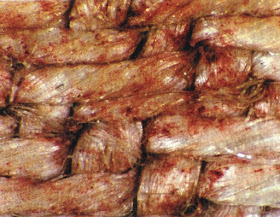

I'm invoking the "any shroud related topic on newest post" rule.
ReplyDeleteI was recently reading about the Sudarium of Oviedo and noticed that it is almost universally accepted that the radiocarbon dating tests performed on it were inaccurate. I have been able to find very little information on it besides that. Do you have an opinion on the accuracy of this test and do you think its inaccuracy has any bearing on your theories regarding the carbon dating of the Shroud?
Kyle
ReplyDelete>I'm invoking the "any shroud related topic on newest post" rule.
No need to invoke it. As long as a comment is not "offensive or sub-standard" then if it is "under my latest post [it] can be on any one Shroud-related topic" without being "off-topic" (see my policies below).
>I was recently reading about the Sudarium of Oviedo and noticed that it is almost universally accepted that the radiocarbon dating tests performed on it were inaccurate.
It wasn't that it was "inaccurate" but according to the then Director of the Arizona radiocarbon dating laboratory, Paul Damon, "the dating was never carried out":
See my post 28Jul12 (words in bold are the Shroud sceptic Charles Freeman's):
----------------------------------
Freeman continues to mislead his readers by selectively concealing from them relevant information in his claim that the Sudarium has had "a radiocarbon-14 dating apparently of c. 700 AD":
Those trying to assess the authenticity of the Sudarium of Oviedo have to contend with a radiocarbon-14 dating apparently of c. 700 AD.
But Freeman's claim is misleading (and what's more, since he surely must have read Guscin's book, he knows it is misleading) that "the Sudarium of Oviedo "had ... a radiocarbon-14 dating ... of c. 700 AD." What Freeman does not tell his readers is that Guscin went into this very thoroughly in his book, detailing his correspondence with the Tucson Arizona radiocarbon dating laboratory, and he concluded:
"The only conclusion that can be drawn from this, and the Tucson laboratory would seem to agree, is that the whole affair was something of a shambles. Mr Jull ends his fax to me offering to carry out a serious radiocarbon dating on a sample of interest. The samples were not taken with permission for radiocarbon dating, and had presumably been taken by Monsignor Ricci about 15 years before being sent to Tucson. When sent, insufficient provenance information accompanied them; one of the samples was even stated to be 11th century. Paul Damon says the dating was never carried out, and in the results sent to Italy the sample numbers do not coincide. The laboratory suggests a serious experiment. Taking all this into account, the supposed results of the carbon dating of the sudarium can safely be ignored." ([Guscin, M., 1998, "The Oviedo Cloth," Lutterworth Press: Cambridge UK,] pp.83-84)."
----------------------------------
>I have been able to find very little information on it besides that.
See above.
[continued]
[continued]
ReplyDelete>Do you have an opinion on the accuracy of this test ...
See above that there was no test, or if there was one, it was so flawed that the Arizona radiocarbon dating laboratory has disowned it.
But in general, if a radiocarbon date disagreed with other historical information (e.g. the Sudarium of Oviedo left Jerusalem in AD 614 - see my 24Jan17) then it is the radiocarbon date that is wrong, presumably due to contamination with younger carbon.
>and do you think its inaccuracy has any bearing on your theories regarding the carbon dating of the Shroud?
This is particularly so with the Shroud. The evidence is overwhelming that the Turin Shroud is authentic and the laboratories and Nature should have taken that into account. It is a form of scientific fraud to state the result of a scientific test without acknowledging the evidence against your result.
The standard of scientific honesty that all scientists, including those involved in the radiocarbon dating of the Shroud, should adhere to is that set by the late Professor of Physics at Caltech, Richard P. Feynman (1918–1988) (my emphasis):
"It's a kind of scientific integrity, a principle of scientific thought that corresponds to a kind of utter honesty - a kind of leaning over backwards. For example, if you're doing an experiment, you should report everything that you think might make it invalid-not only what you think is right about it: other causes that could possibly explain your results; and things you thought of that you've eliminated by some other experiment, And how they worked-to make sure the other fellow can tell they have been eliminated. Details that could throw doubt on your interpretation must be given, if you know them. You must do the best you can-if you know anything at all wrong, or possibly wrong-to explain it. If you make a theory, for example, and advertise it, or put it out, then you must also put down all the facts that disagree with it, as well as those that agree with it ... the idea is to try to give all of the information to help others to judge the value of your contribution; not just the information that leads to judgment in one particular direction or another ... I'm talking about a specific, extra type of integrity that is not lying, but bending over backwards to show how you're maybe wrong, that you ought to have when acting as a scientist." (Feynman, R.P., 1985, "Surely You're Joking, Mr Feynman!," Unwin Paperbacks: London, Reprinted, 1990, pp.340-343)
Stephen E. Jones
----------------------------------
MY POLICIES. Comments are moderated. Those I consider off-topic, offensive or sub-standard will not appear. Except that comments under my latest post can be on any one Shroud-related topic. To avoid time-wasting debate I normally allow only one comment per individual under each one of my posts.